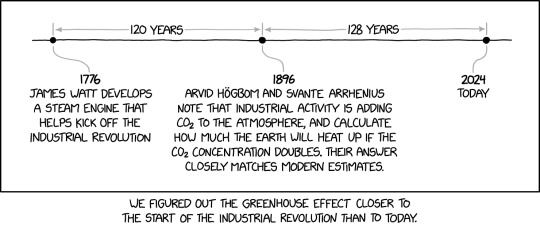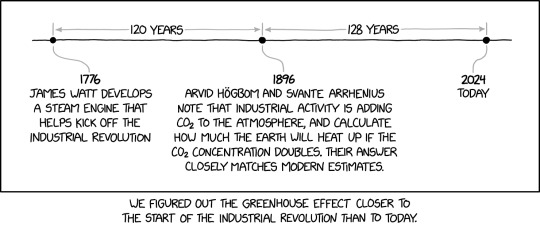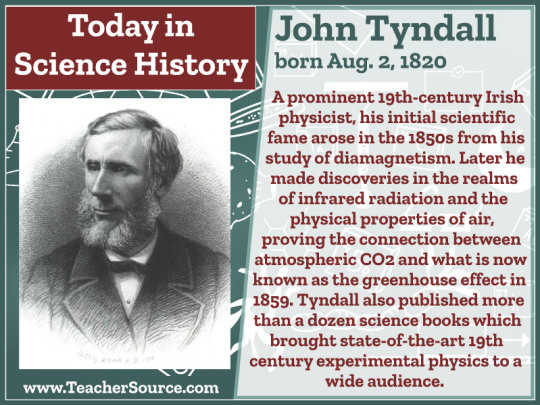#greenhouse effect
Text

Once he had the answer, Arrhenius complained to his friends that he'd "wasted over a full year" doing tedious calculations by hand about "so trifling a matter" as hypothetical CO2 concentrations in far-off eras (quoted in Crawford, 1997).
Greenhouse Effect [Explained]
Transcript
[At the top of the comic a timeline is shown as a long line. It has three dots, one at each end a bit inside the end of the line and one close to the middle Each dot has a gray curved line going up to it from below. Below the end of these lines a year is given. And beneath the year is a caption. Above the time line are two gray double arrows going from three gray lines above each of the three dots. The lines are broken in the middle where a label is written.]
[Label of arrow that spans from first to second dot:] 120 years
[Label of arrow that spans from second to third dot:] 128 years
[Label for the first dot:] 1776 James Watt develops a steam engine that helps kick off the Industrial Revolution
[Label for the second dot:] 1896 Arvid Högbom and Svante Arrhenius note that industrial activity is adding CO2 to the atmosphere, and calculate how much the Earth will heat up if the CO2 concentration doubles. Their answer closely matches modern estimates.
[Label for the third dot:] 2024 Today
[Caption below the panel:] We figured out the greenhouse effect closer to the start of the Industrial Revolution than to today.
1K notes
·
View notes
Text
A lesson on the greenhouse effect; Dr. Carl Sagan testified before Congress in 1985 on climate change l carlsagandotcom/full vid
#climate change#greenhouse effect#earth#climate crisis#environment#carl sagan#informative#science#planets#greenhouse gases#global warming
1K notes
·
View notes
Text
InfoWars Report: 1982 CBS Climate Change Lies 🤔
#pay attention#educate yourselves#educate yourself#knowledge is power#reeducate yourself#reeducate yourselves#think about it#think for yourselves#think for yourself#do your homework#do some research#do your own research#ask yourself questions#question everything#climate change#climate crisis#greenhouse effect#you decide#news#infowars#lies exposed
132 notes
·
View notes
Photo

(via xkcd: Greenhouse Effect)
96 notes
·
View notes
Text
First use of "Greenhouse Effect" in SF

A scan of Frederik Pohl and C.M. Kornbluth's "Gravy Planet" from Galaxy magazine's August 1952 issue.
The story grew into the brilliant anti-capitalist novel, The Space Merchants.
#greenhouse effect#Gravy Planet#The Space Merchants#science fiction#Frederik Pohl#CM Kornbluth#my screencaps
32 notes
·
View notes
Text
Article from the Hindustan Times about why Venus is the hottest planet, despite not being the closest to the Sun
#heat#greenhouse effect#hot#venus#Hindustan Times#planetary science#planetary studies#planets#planet venus#solar system#climate#venusian climate#venusian
8 notes
·
View notes
Text
I have been going through the backlog of emails that accumulated over my more depressive time when I didn't have the energy to deal with them and found a comic from xkcd that kinda makes me even sadder and angrier about how stupid we, as humans overall, are about the environment:

#xkcd#ecology#environment#greenhouse effect#why the fuck are hoomans?#we are ruining the world#AND WE FUCKING KNOW IT#but there's barely any movement to change it
2 notes
·
View notes
Text

International Polar Bear Day 2024 國際北極熊日
HEY HUMAN, SEE WHAT YOU DO!?
ANIMAN - FLOATING POLAR 浮冰熊
Instagram: milkdongcomics
Facebook: Milk DoNg Comics
#國際北極熊日#International Polar Bear Day#北極熊#Polar Bear#節約能源#Energy Conservation#全球暖化#Global Warming#溫室效應#Greenhouse Effect#ANIMAN#HEY HUMAN SEE WHAT YOU DO!?#Milk DoNg#Milk DoNg Comics#Art#Drawing#Sketching#Painting#Illustration#Character Design#Color Pencil
4 notes
·
View notes
Text

John Tyndall was born on August 2, 1820. A prominent 19th-century Irish physicist, his initial scientific fame arose in the 1850s from his study of diamagnetism. Later he made discoveries in the realms of infrared radiation and the physical properties of air, proving the connection between atmospheric CO2 and what is now known as the greenhouse effect in 1859. Tyndall also published more than a dozen science books which brought state-of-the-art 19th century experimental physics to a wide audience.
#john tyndall#physics#co2#greenhouse gases#greenhouse effect#science#science history#science birthdays#on this day#on this day in science history
4 notes
·
View notes
Video
youtube
How Fascists Are Taking Advantage Of Climate Change by Second Thought
#thought provoking#evils of capitalism#global warming#cliamte change#greenhouse effect#fascism#nationalism#eco-fascism#291/365
2 notes
·
View notes
Text
Carbon Dioxide — The Gas of Life
youtube
Story at-a-glance
Carbon dioxide (CO2) is commonly mischaracterized as a harmful waste product of respiration and is falsely blamed for disrupting the planetary climate
CO2 is an essential gas necessary for life. Moreover, its impact on Earth’s temperatures is negligible, and will remain negligible even if the current concentration in the atmosphere were to double. A 100% increase of CO2, from 400 ppm to 800 ppm, would decrease radiation into space by just 1.1%, resulting in a 0.7 degree C increase of the average earth temperature
A 0.7 degree C difference means there’s no climate emergency, and no matter what we do to reduce CO2 emissions, it’s not going to impact global temperatures. To fabricate an emergency where there is none, it is assumed that massive positive feedbacks are involved. However, most natural feedbacks are negative, not positive, so isn’t it likely the 0.7 degree C increase is an overestimation to begin with
There’s no single temperature of the Earth. It varies by location and altitude. For every kilometer of altitude, you have an average cooling of 6.6 degrees C
Higher CO2 levels will green the planet, making it more hospitable to plant life. The more CO2 there is, the better plants and trees grow. CO2 also reduces the water needs of plants, reducing the risks associated with droughts
The video above, “CO2, The Gas of Life,” features a lecture given at the Summit Old Guard Meeting in New Jersey, October 3, 2023, by William Happer, Ph.D., Professor Emeritus of physics at Princeton University and former scientific adviser to the Bush and Trump administrations.
The topic: carbon dioxide (CO2), commonly mischaracterized as a harmful waste product of respiration and a pollutant that is disrupting the planetary climate. As explained by Happer in this lecture, CO2 is actually an essential gas necessary for life. Moreover, its impact on Earth’s temperatures is negligible, and will remain negligible even if the current concentration in the atmosphere were to double.
CO2 Is Not a Pollutant
At present, the CO2 concentration in the atmosphere at a few thousand feet of elevation is around 430 parts per million (ppm). Closer to the ground, concentrations vary widely, both by location and time of day. This is because ground-level readings are impacted by photosynthesis and the respiration of insects and the like.
In the room where Happer was giving his lecture, the CO2 reading was 1,800 ppm — the result of having a large group of people breathing in a closed space. Air conditioning systems have CO2 meters that turn on fans to bring outdoor air inside when levels get too high.
The question of what is too high is an important one, considering The Great Resetters are pushing a green agenda that demands the dismantling of energy infrastructure and farming in the name of stopping climate change, which quite obviously threatens our quality of life and food supply. Ultimately, it may threaten human existence altogether.
The fact of the matter is that CO2 is not the “bad guy” it’s made out to be, and the “net zero” agenda is wholly inappropriate if maintaining life on Earth is part of the equation.
“CO2 is a very essential and natural part of life,” Happer says. “It is the gas of life. We’re made of carbon after all, mostly carbon, and we breathe out a lot of CO2 a day just by living. Each of us breathes out about 2 pounds of CO2 a day. Multiply that by 8 billion people and 365 days a year, and just [by] living, people are a non-negligible part of the CO2 budget of the Earth.
Nevertheless, we are living through a crusade against so-called pollutant CO2. People talk about carbon pollution. [But] every one of us is polluting Earth by breathing, [so] if you want to stop polluting ... apparently God wants us to commit suicide ...
We're doing all sorts of crazy things because of this alleged pollutant ... more and more beautiful meadows are being covered with black solar panels. It doesn't work very well; it doesn't work at all at night. It doesn't work on cloudy days. It doesn't work terribly well in the middle of the winter because of the angle of the sun.
But nevertheless we're doing it. We’re being misled into climate hysteria, and if you haven't read this book, I highly recommend it. It was published first in 1841, called ‘Extraordinary Popular Delusions and the Madness of Crowds.’ It’s as relevant today as it was then ...
I'm a physicist. I'm proud to say that no one could call me a climate scientist, but I know a lot about climate and I was a coauthor of one of the first books on the effects of carbon dioxide 41 years ago. This was a study done by the Jason Group which I was a member of. I was chairman for a while and it had really good people there.”
Long-Term Impact of Increasing Atmospheric CO2
The key question when it comes to global warming is, how much do you warm the Earth if you double the atmospheric CO2 concentration? This is called the climate sensitivity question. The GUESS is that doubling CO2 would result in a 3-degree centigrade rise in the global temperature.
“It was not based on any hard calculations,” Happer says. “It was because of group-think. That's what everybody else thought, and so that's what we thought. Now, in my defense, one of the reasons I didn't pay much attention to this [is because] I was working on something at this time that I thought was much more important. So, let me tell you about that, so you get a feeling for why I think I'm qualified to pontificate about this subject.
It was the beginning of the Strategic Defense Initiative, of Star Wars ... President Reagan ... wanted some way to defend the United States so that we didn't have to have this mass suicide pact, and among other things we considered using high-powered lasers to burn up incoming missiles ...
But here's the problem. If you take the 1 megawatt laser on the ground and you send it toward the missile, by the time it gets to the missile, the beam — instead of focusing all the power on the missile — breaks up into hundreds of sub beams — speckles — and this was something that was well-known to astronomers. You have the same problem when you're looking at distant stars and galaxies.
Astronomers knew how to fix this ... If you can measure how much this wave is bent, then you can bounce it off a mirror bent in the opposite direction, and when the wave bounces up it's absolutely flat. That's called adaptive optics and it works beautifully. Then, when you focus the corrected beam, you get a single spot instead of hundreds of [beams].
The trouble with that is that if you look at the night sky, there are only four or five stars that are bright enough to have enough photons to do the measurement of the distortion of the wave. So, we had a classified meeting in the summer of 1982. There were a number of Air Force officers there who explained the problem. By chance, I knew how to solve it.
You can make an artificial star anywhere in the sky by shining a laser tuned to the sodium frequency onto the layer of sodium above our heads, at 90 to 100 kilometers.”
While the Air Force was initially dubious about there being a sodium layer in the atmosphere, they did eventually build the sodium laser proposed by Happer, and if you go to any ground-based telescope today, you'll usually see one or two of them. Anyway, that story was simply to impress you with the fact that Happer knows what he’s talking about when it comes to atmospheric constituents and their related phenomena.
CO2 Has No Discernible Impact on Earth Temperatures
According to the climate alarmists, rising CO2 will result in global warming that will threaten all life on earth. In actuality, however, CO2 “is a very puny tool to do anything to the climate,” Happer says.
Keep in mind that there’s no single temperature on the Earth. It varies by location and altitude. For every kilometer of altitude, you have an average cooling of 6.6 degrees C. This is known as the lapse rate. That cooling continues up to the troposphere, where it stops.
The cooling is due to the fact that warm air rises and cool air descends. “It’s the convection that sets that rapid drop of temperatures — 6-and-a-half degrees per kilometer,” Happer says. He then explains the following graph, which details the thermal radiation to space from the Earth, assuming a surface temperature of 15.5 degrees C. The greenhouse gases is the area beneath the jagged black curve.
According to Happer, this is only 70% of what it would be without greenhouse gases, which is shown as the smooth blue curve, because as the sun heats the earth, greenhouse gases — mostly water vapor — impede cooling.
The most important part of this graph is the red jagged line, shown here with a red arrow pointing to it. That red line shows the effect that a doubling (a 100% increase) of CO2 would have on the surface temperature of Earth. As you can see, it’s negligible. It decreases radiation into space by just 1.1%.

As noted by Happer:
“Let that sink in. We’re far from doubling [CO2] today. It'll take a long time, [and] it only causes a 1% change. So, CO2 is a very poor greenhouse gas. It's not an efficient greenhouse gas.”
If you remove ALL CO2, you end up with the green jagged curve. As you can see, the green and black jagged lines run parallel with the exception of one spot. There’s a huge effect if you go from zero CO2 to 400 ppm (green arrow). But it’s again negligible when you go from 400 ppm to 800 ppm (black arrow). As explained by Happer:
“You get all of the effect in the first little bit of added CO2 ... So, it's really true that doubling CO2 only causes a 1% decrease of radiation. The IPCC [Intergovernmental Panel on Climate Change] gets the same answer so this is not really controversial, although they will never show you the curve or tell you that it's 1%. That would interfere with the narrative ...
So, this is radiation to space. How do you change that into a temperature? They're worried that we'll get intolerable warming of the surface of the Earth where we live, or other parts of the atmosphere.
Here again it's important to do the first order calculation ... and it says that the warming from doubling CO2 is ... less than one degree ... 0.7 [degree] C. Very small. You really can’t feel that.”
Why, Then, the Alarm Over Rising CO2?
Needless to say, this is a huge problem for the climate science community, because a 0.7 degree C difference means there’s no climate emergency, and no matter what we do to reduce CO2 emissions, it’s not going to impact the climate.
So, to fabricate an emergency where there really is none, the IPCC “assumes enormous positive feedbacks,” Happer says. Because CO2 is not a potent greenhouse gas, the tiny direct warming caused by it is amplified by factors of anywhere from four to six to make it seem like it has a discernible impact.
“I like to say it's affirmative action for CO2,” Happer says. “It’s not very good at warming but if you assume lots of feedback, you can keep the money coming in.” The problem with that is that most who have a background in physical chemistry and physics know that most natural feedbacks are negative, not positive.
“The 0.7 degree C of warming you get when you double the CO2 is probably an overestimate, because there are probably negative feedbacks operating in this very complicated climate system that we live in.” ~ William Happer, Ph.D.
This is known as the Chatelier Principle, named after the French chemist who first discovered that “when a simple system in thermodynamic equilibrium is subjected to a change in concentration, temperature, volume or pressure ... the system changes to a new equilibrium and ... the change partly counteracts the applied change.”
So, the 0.7 degree C of warming you get when you double the CO2 is “probably an overestimate,” Happer says, “because there are probably negative feedbacks operating in this very complicated climate system that we live in. The atmosphere, the oceans, everything is nonlinear.”
The key take-home from all this is that whether we’re at 400 ppm of CO2 or 800 ppm doesn’t matter when it comes to impacting the temperature of the earth. In short, the climate hysteria is just that. It’s not based on any real threat. Only if we were able to get to absolute zero CO2 would there be a change, but doing so also means we’d exterminate all living things on the planet. It’s nothing short of a suicide agenda.
More CO2 Will Green the Planet
As explained by Happer, more CO2 will green the planet, making it more hospitable to plant life. The more CO2 there is, the better plants and trees grow, so if we want lush forests and bountiful harvests, cutting CO2 is the last thing we’d want to do.
“All plants grow better with more CO2 [in the air],” he says. “Plants are really starved [of] CO2 today. We know plants need many essential nutrients. They need nitrogen, phosphorus, potassium; most important of all they need water. But they also need CO2, and like many of the other nutrients, CO2 today is in short supply.”
CO2 benefits plants by reducing their water needs, hence less risk from drought. Higher CO2 levels also reduce harmful photorespiration. According to Happer, C3-type plants lose about 25% of their photosynthesis potential due to increased photorespiration. For more in-depth information about the role of CO2 in plant growth and photosynthesis, please view the video. This discussion begins around the 40-minute mark.
Lies, Ignorance, Stupidity or Something Else?
In closing, Happer makes an effort to explain what’s driving the climate hysteria:
“In spite of incontrovertible arguments that there is no climate emergency — CO2 is good for the Earth — the campaign to banish CO2, ‘net zero,’ has been very successful. So, how can that be? I’m really out of my depth here because now I'm talking about human nature. I'm really good with instruments and with solving differential equations but I'm not very good at understanding human beings.
But here are some of the drivers: noble lies, political lies, ignorance, stupidity, greed. Noble lies goes back to Plato who discusses it in ‘The Republic.’ ‘In politics, a noble lie is a myth or untruth, often, but not invariably of a religious nature, knowingly propagated by an elite to maintain social harmony or to advance an agenda.’
And here there's a clear agenda. If you could somehow unite mankind to fight some external threat, for example CO2 pollution, then we won't fight each other. There won't be wars. So, I think many sincere people have latched on to the CO2 narrative partly for that reason. You can actually read about it in the early writings of the Club of Rome.
Then there are political lies. This is one my favorite H.L. Menken quotes: ‘The whole aim of practical politics is to keep the populace alarmed (and hence clamorous to be led to safety) by menacing it with an endless series of hobgoblins, all of them imaginary.’”
Ignorance, of course, is widespread, and largely based on incomplete knowledge or a flawed understanding of the facts. And what of stupidity? Dietrich Bonhoeffer, one of the few German clergymen who opposed Hitler and eventually paid for his public dissent with his life, once wrote about human stupidity:
“Against stupidity we have no defense. Neither protest nor force can touch it. Reasoning is of no use. Facts that contradict personal prejudices can simply be disbelieved — indeed, the fool can counter by criticizing them, and if they are undeniable, they can just be pushed aside as trivial exceptions.
So the fool, as distinct from the scoundrel, is completely self-satisfied. In fact, they can easily become dangerous, as it does not take much to make them aggressive. For that reason, greater caution is called for than with a malicious one.”
Happer himself has experienced the danger of opposing stupidity. “I regularly get phone calls threatening me, my wife and children with death,” he says. “So, what kind of movement is this?” Lastly, greed. A.S. Pushkin once said, “If there should happen to be a trough, there will be pigs.” And climate science is currently where the big bucks are — provided your work furthers the global warming narrative and the need for net zero emissions.
Whatever the drivers are, responsible people everywhere need to push back against the false climate change narrative and the net zero agenda, as it will accomplish nothing in terms of normalizing temperatures, but will rapidly erode quality of life and the sustainability of food production, and shift wealth into the hands of the few.
#climate change#fossil fuels#government corruption#carbon dioxide#greenhouse effect#climate change fraud#Youtube
1 note
·
View note
Text
Let’s not celebrate the earth only during the Earth Day. Remember, Earth is our only home. And it needs you, your care and love more than ever now.
Every photo & video in the video above is taken by me throughout the years in different locations. The animated illustration art on the first image is a real photo of Greenland (flight view).
© Eclectic Ways
The insta tag in the video is my personal insta account. Please don’t add me there. I only accept the people I know. I had to use the video like this as I created it through instagram template and music back in the time.
#earth day#earth#enviroment art#global warming#greenhouse effect#landscape#landscape photos#animals#mass extinction#warning#curators on tumblr#climate change#climate and environment#climate action#climate emergency#environmental issues#environmentalism
4 notes
·
View notes
Text
Last 8 years on track to become hottest ever: WMO
Last 8 years on track to become hottest ever: WMO
In an interim report from the “State of the Global Climate 2022”The WMO assured that this year’s extreme heatwaves, droughts and devastating floods “affected millions of people and caused billions of losses”.
He also pointed out that it is currently estimated that the global average temperature in 2022 will be about 1.15 . will exceed [de 1,02 a 1,28] °C is the average of the pre-industrial…
View On WordPress
5 notes
·
View notes
Video
youtube
GreenHouse Effects Paragraph For JSC, SSC, HSC 2023
2 notes
·
View notes
Video
youtube
Dan Peña - Is Global Warming The Greatest Fraud? - 50 Billion Dollar Man By London Real
UPDATE: False information
#Global Warming#london real#climate change#green#Environment#world#earth#politics#us government#bank#money#greenhouse effect#greed#Dan Peña#millionaire#billionaire#hot#usa#science#investment#the wall street journal#wall street#forest#tree
1 note
·
View note
Text
The Seriousness of Global Warming
Total annual global temperature rise during the Industrial Revolution has been little over 1 degree Celsius, or over 2 degrees Fahrenheit. It increased on average by 0.07 degrees Celsius (0.13 degrees Fahrenheit) per 10 years between 1880—the year that accurate recordkeeping started—and 1980. The rate of growth, however, has more than doubled since 1981: Over the past 40 years, the yearly global temperature has increased by 0.18 degrees Celsius, or 0.32 degrees Fahrenheit, every decade.The outcome? a world with unprecedented heat. Since 2005, nine of the ten warmest years on record since 1880 have happened, and the last five warmest years have all happened since 2015.Now, climate scientists have concluded that if we want to prevent a future in which daily life throughout the world is marked by its worst, most devastating effects: the extreme droughts, wildfires, floods, tropical storms, and other disasters that we refer to collectively as climate change, we must limit global warming to 1.5 degrees Celsius by 2040. The greenhouse effect is the result of these heat-trapping pollutants, notably carbon dioxide, methane, nitrous oxide, water vapour, and synthetic fluorinated gases, which are referred to as greenhouse gases.Although the earth's climate has changed several times over the past 800,000 years due to natural cycles and fluctuations, our current era of global warming is solely attributable to human activity, specifically the burning of fossil fuels like coal, oil, gasoline, and natural gas, which creates the greenhouse effect. Scientists concur that longer and hotter heat waves, more frequent droughts, heavier rains, and stronger hurricanes are all being fueled by the earth's warming climate. For instance, scientists determined in 2015 that global warming had increased the severity of a protracted drought in California—the state's greatest water scarcity in 1,200 years—by 15 to 20%. They added that over the previous century, the likelihood of future droughts of a similar magnitude had almost doubled. We can now confidently link some extreme weather events, such as heat waves, droughts, and heavy precipitation, to climate change, according to a 2016 National Academies of Science, Engineering, and Medicine report. Additionally, the oceans' temperatures are rising, which allows tropical storms to intensify. In other words, global warming has the power to upgrade a category 3 hurricane to a category 4 storm, which is more hazardous. In fact, researchers have discovered that both the number of storms that reach categories 4 and 5 as well as the frequency of North Atlantic hurricanes have increased since the early 1980s. A record-breaking 30 tropical storms, 6 major hurricanes, and 13 hurricanes were all recorded during the 2020 Atlantic hurricane season. Increased intensity causes more harm and death. Everywhere, the effects of global warming are being felt. In recent years, extreme heat waves have been responsible for tens of thousands of fatalities worldwide. Additionally, Antarctica has lost nearly four trillion metric tonnes of ice since the 1990s, which is a worrying portent of future events. Every year, scientists discover more information about the effects of global warming, and every year, we amass more proof of the catastrophic harm it causes to both people and the environment. Communities suffer, and the number of fatalities rises, as the heat waves, droughts, and floods brought on by climate change grow more regular and severe. Scientists predict that if we don't cut back on our emissions, climate change could kill more than 250,000 people annually and push 100 million people into poverty by 2030. The United States is already feeling the effects of global warming. Here are just a few of the potential consequences if we are unable to control our emissions.
Cities, farms, and forests will see more bothersome bugs, heat waves, torrential downpours, and flooding. Agriculture and fisheries may be harmed or destroyed by all of these.
Many plant and animal species may go extinct if environments like coral reefs and alpine meadows are damaged. Increased pollen-producing ragweed growth, increased levels of air pollution, and the spread of conditions that are conducive to pathogens and mosquitoes will all lead to an increase in the frequency of allergic reactions, asthma attacks, and infectious disease outbreaks.
Despite the fact that everyone is impacted by climate change, not everyone is equally impacted. Typically, those who are indigenous, persons of colour, or economically marginalised are severely harmed. Even though these same communities have made the least effort to contribute to climate change, they are more vulnerable to its worst effects due to inequities built into our housing, healthcare, and labour systems.
Many plant and animal species may go extinct if habitats like coral reefs and alpine meadows are damaged. Increased pollen-producing ragweed growth, increased levels of air pollution, and the spread of conditions that are conducive to pathogens and mosquitoes will all lead to an increase in the frequency of allergic reactions, asthma attacks, and infectious disease outbreaks.
And while new federal and state standards are a step in the right direction, much more needs to be done. Voice your support of climate-friendly and climate change preparedness policies, and tell your representatives that equitably transitioning from dirty fossil fuels to clean power should be a top priority—because it’s vital to building healthy, more secure communities
3 notes
·
View notes